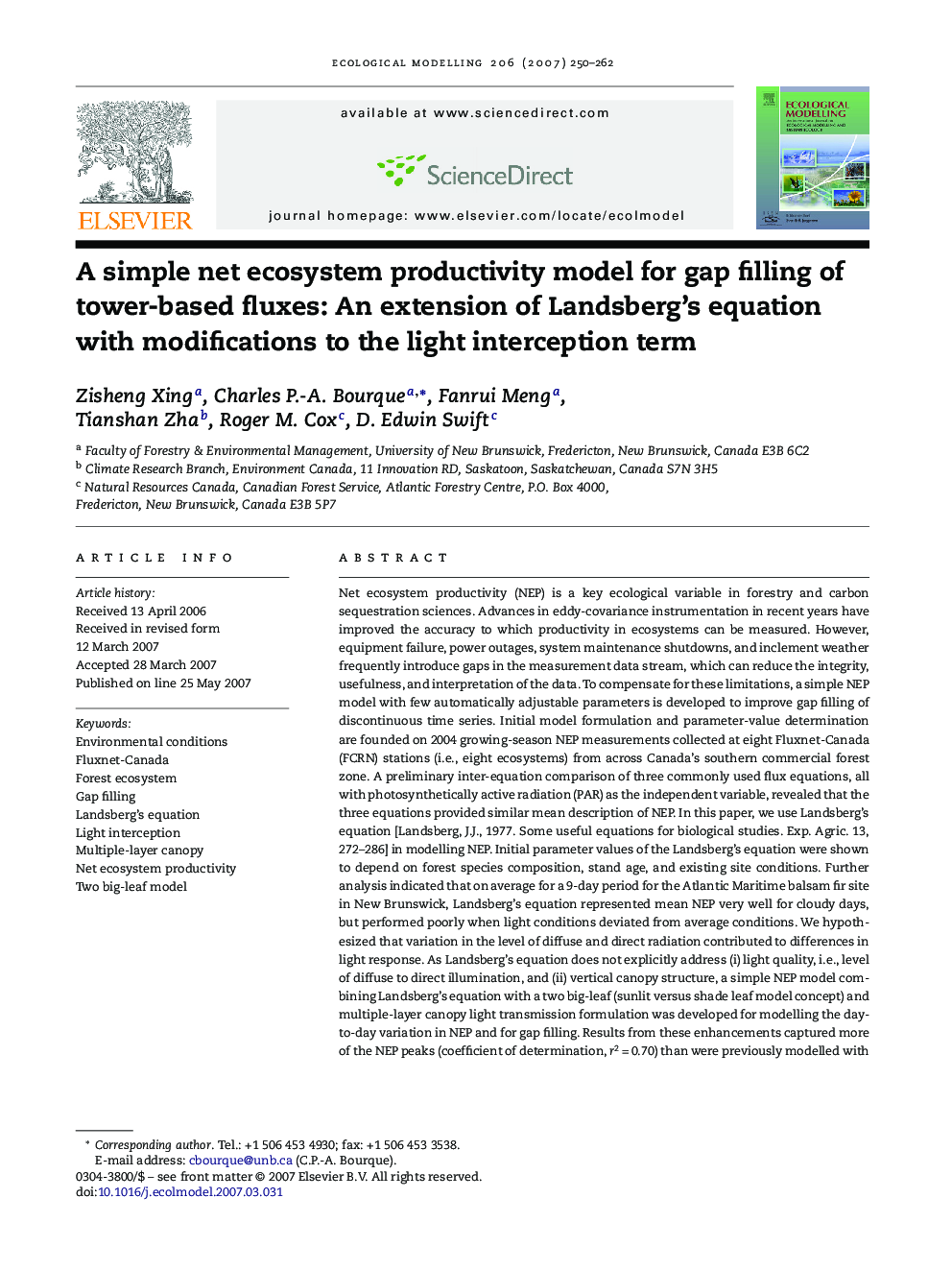| کد مقاله | کد نشریه | سال انتشار | مقاله انگلیسی | نسخه تمام متن |
|---|---|---|---|---|
| 4378640 | 1617544 | 2007 | 13 صفحه PDF | دانلود رایگان |
عنوان انگلیسی مقاله ISI
A simple net ecosystem productivity model for gap filling of tower-based fluxes: An extension of Landsberg's equation with modifications to the light interception term
دانلود مقاله + سفارش ترجمه
دانلود مقاله ISI انگلیسی
رایگان برای ایرانیان
کلمات کلیدی
موضوعات مرتبط
علوم زیستی و بیوفناوری
علوم کشاورزی و بیولوژیک
بوم شناسی، تکامل، رفتار و سامانه شناسی
پیش نمایش صفحه اول مقاله

چکیده انگلیسی
Net ecosystem productivity (NEP) is a key ecological variable in forestry and carbon sequestration sciences. Advances in eddy-covariance instrumentation in recent years have improved the accuracy to which productivity in ecosystems can be measured. However, equipment failure, power outages, system maintenance shutdowns, and inclement weather frequently introduce gaps in the measurement data stream, which can reduce the integrity, usefulness, and interpretation of the data. To compensate for these limitations, a simple NEP model with few automatically adjustable parameters is developed to improve gap filling of discontinuous time series. Initial model formulation and parameter-value determination are founded on 2004 growing-season NEP measurements collected at eight Fluxnet-Canada (FCRN) stations (i.e., eight ecosystems) from across Canada's southern commercial forest zone. A preliminary inter-equation comparison of three commonly used flux equations, all with photosynthetically active radiation (PAR) as the independent variable, revealed that the three equations provided similar mean description of NEP. In this paper, we use Landsberg's equation [Landsberg, J.J., 1977. Some useful equations for biological studies. Exp. Agric. 13, 272-286] in modelling NEP. Initial parameter values of the Landsberg's equation were shown to depend on forest species composition, stand age, and existing site conditions. Further analysis indicated that on average for a 9-day period for the Atlantic Maritime balsam fir site in New Brunswick, Landsberg's equation represented mean NEP very well for cloudy days, but performed poorly when light conditions deviated from average conditions. We hypothesized that variation in the level of diffuse and direct radiation contributed to differences in light response. As Landsberg's equation does not explicitly address (i) light quality, i.e., level of diffuse to direct illumination, and (ii) vertical canopy structure, a simple NEP model combining Landsberg's equation with a two big-leaf (sunlit versus shade leaf model concept) and multiple-layer canopy light transmission formulation was developed for modelling the day-to-day variation in NEP and for gap filling. Results from these enhancements captured more of the NEP peaks (coefficient of determination, r2Â =Â 0.70) than were previously modelled with the unaltered form of Landsberg's equation (r2Â =Â 0.63). Model sensitivity analysis suggested partitioning the canopy in four canopy layers provided the best overall improvement in NEP calculations; beyond four layers, model improvement was minor.
ناشر
Database: Elsevier - ScienceDirect (ساینس دایرکت)
Journal: Ecological Modelling - Volume 206, Issues 3â4, 24 August 2007, Pages 250-262
Journal: Ecological Modelling - Volume 206, Issues 3â4, 24 August 2007, Pages 250-262
نویسندگان
Zisheng Xing, Charles P.-A. Bourque, Fanrui Meng, Tianshan Zha, Roger M. Cox, D. Edwin Swift,